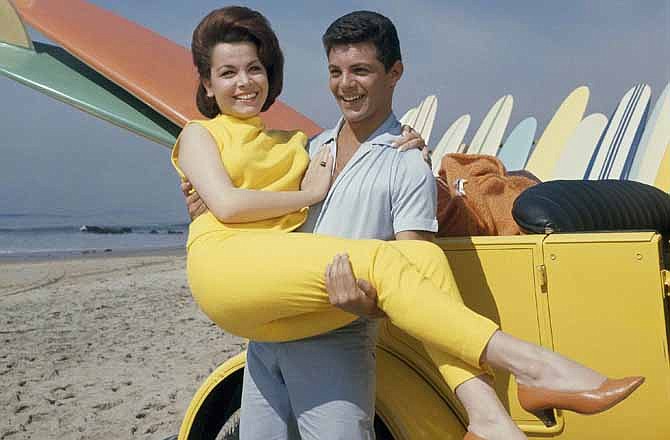LOS ANGELES (AP) - When she traded in her Mousketeer ears for a surfboard and a modest one-piece bathing suit, Annette Funicello helped create a world as fanciful as Walt Disney's Magic Kingdom.
It was the land of perfect waves and sparkling sand, in a place where there was a beach party every night and summer never ended - at least not until the Frankie and Annette "Beach Party" movie did.
When Funicello, who died this week at age 70, climbed into a convertible with Frankie Avalon in the opening moments of 1963's "Beach Party" and sang, "They'll be surfin' all day and they'll be swingin' all night. Vacation is here. Beach party tonight!" she helped introduce America to Southern California's beach culture.
"In 1964, I moved here from Teaneck, New Jersey. A girl in my ninth grade class, I wish I could remember her name, said to me, "Wow! Now you'll get to go surfing,"' recalled David Rensin, who lives in a home that overlooks the Pacific Ocean.
The author of more than a dozen books not only learned to surf once he got here, he went on to write the definitive biography of Miki "Da Cat" Dora, arguably the greatest outlaw surfer who ever lived and a stunt double in most of those Frankie and Annette movies.
Today, Southern California kids still go to the beach and catch waves, but there's not nearly the freedom or the access that Funicello's films celebrated. There are far more surfers crowding the waves, that's true, but it's hard to find the on-the-sand goofiness and camaraderie portrayed in "Beach Blanket Bingo" or "How to Stuff a Wild Bikini." And nobody is writing songs like "Surfin' Safari," "Surfin USA" or "Secret Surfing Spot."
But then it's a different time, notes University of Southern California pop culture historian Leo Braudy.
"Certainly there are lots of surfers still around, but they're not as fascinating as they used to be," Braudy said. "Things move on. The culture gets fascinated by other things. People say, "All right, we already did the beach. Yes, we know California has a beach. Now let's look at something else."'
There are video games to be played, social networks to be surfed and a million of others things to do.
"It's more defused now," Braudy said. "What do kids think about? What do kids on the East Coast or the West Coast do? Where do they believe their dream place is? I don't think there's one anymore. There might be several. But back then it was California."
Southern California, too, has changed.
It's more multi-ethnic, with more cultures bringing a variety of more pastimes to engage in. It's also far more crowded, making it far harder to get to the beach and to park anywhere near the sand once there.
And the bonfires the kids always danced around in those "Beach Party" movies? As more and more people have moved to Southern California's beaches, efforts have been launched to ban the bonfires to control air pollution. The South Coast Air Quality Management District is expected to take up the issue next month.
Meanwhile, those rickety beachfront shacks that once dotted the coastline are all but gone, replaced by multimillion-dollar homes.
Rensin left Los Angles some time ago to move up the coast to Ventura, one of Southern California's still relatively uncrowded and affordable beachfront cities.
"So I don't want a lot of people to find out about it," he laughs.
But when it comes to going to the beach and driving your woody - that old, wood-paneled station wagon that you could fit a surfboard into the back of - right onto the sand like Annette's friends did in all those movies, well, forget about it. It mainly only happened in those movies and on Beach Boys album covers.
The only California beach you can legally drive a car onto is Oceano Dunes, near Pismo Beach, along the central California coast.
You might have done it at Malibu back in the early 1960s, when there were no lifeguards around to chase you away, but if you did you'd probably get stuck in the sand. Today, you might get arrested.
"I never saw a car parked on the sand. We didn't even have a parking lot. We parked on the street," laughed Kathy Kohner Zuckerman, who in her days shooting the curl regularly at Malibu was better known as Gidget. (Yes, that Gidget, the one her father, Frederick Kohner, based the novel and the 1959 beach movie of the same name on.)
The makeshift shack on the sand that the surfers in "Gidget" constructed so that they had a cheap place to live while they surfed really did exist, Zuckerman says. But it's long gone now, replaced over the years by amenities like a lifeguard tower, restrooms and a parking lot as mansions sprouted on the hills above the water.
But the dream that was launched in those old movies still lives on among some who were young then.
"Every summer I still go to Malibu," says Zuckerman, 72. "I take a board out, I stay close inside and try to paddle into a wave."
Why does she do it?
"Once a surfer," she says, "always a surfer."

